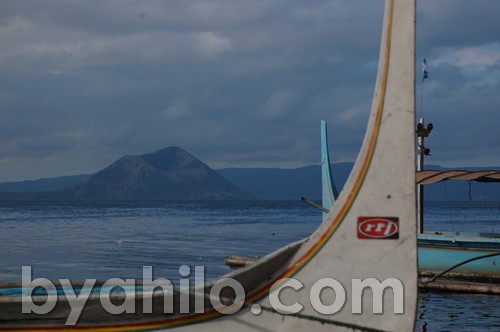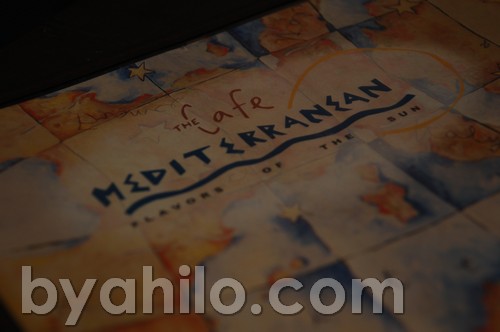Manileño for February 2008
I WAS pawing through some back issues of
TIME Magazine in the throne room, and was amused to find an article published last April that featured—no, not another scandal or coup attempt in the Philippines—the creeping invasion of the United States by non-American fastfood chains, among them none other than Jollibee.
“Jollibee, with more than 1,400 stores in the Philippines and 11 branches in California, makes McDonald's look like a funeral parlor,” wrote Joel Stein. “Its mascot is a jolly bee, and the restaurants are blindingly happy, all giant, shiny yellow blocks, as if they were designed by an architect from Legoland. Even if you gave Walt Disney all the ecstasy in the world, he would not have come up with this. America, according


to Jollibee, is clearly a place of childlike optimism. Jollibee's two most popular items are called the Yumburger and the Chickenjoy. The Yumburger has a weird, plasticky dollop of French dressing in the middle. The crisped-up French fries are dry inside and taste as if they weren't just double fried but dunked in oil four or five times. The fried chicken is halfway decent, but the inflated, happy fakeness of Jollibee makes you feel that the only American its Filipino owners have ever seen is Pamela Anderson.”
As it happened, I’d just taken my mom and our housekeeper that afternoon to—where else?—Jollibee, and I was pretty sure that the smiles on their faces afterward were by no means fake. In fact, when I told them that I was treating them to a late lunch at Jollibee, they brightened up instantly, their minds already knowing what their tongues would be savoring in another 15 minutes or so.
So what was Joel Stein complaining about?
Of course, you and I—and several million other Pinoys and Filipino Americans—know what to tell Mr. Stein and his doubting kind. So sorry, but Jollibee wasn’t made for you; it was made for us, and the only reason it’s in places like Daly City and Cerritos is, well, us, or those of us who happen to live there, hankering amid the blueberry muffins and the stuffed turkey for sweet spaghetti and cereal-fortified burgers (and, yes, greasy fries).
Having lived abroad in different places for some time, I’ve never failed to marvel at how Filipinos are defined by food, which is often just about the only thing that unites us, no matter how fractious Pinoy politics (not just in Caloocan or Cebu, but in Chicago as well) can get. I’m close to believing that we eat not so much for sustenance as for comfort—for the reassurance that the world is still something we know, and even chew on. In the dead of winter,
tinolang manok,
pinakbet, and
binagoongang baboy can be your best friend—plus, of course, that Asian food store proprietor in that suburban mall.
Unfortunately, there’s still no such thing as a global food giant that serves all of the above on demand, over the counter, so we settle for the next best thing, Pinoy fast food, which can only mean Jollibee.
The story of Jollibee’s rise from a hole in the wall in 1978 to the global giant it has become deserves a book of its own (and it did, a few years ago, in a 25th anniversary coffeetable tribute edited by my friend Krip Yuson). Founder Tony Tan Caktiong (who in 2004 was named Ernst & Young’s World Entrepreneur of the Year) has led a company that has consistently been named the country’s best managed. All the good management in the world can’t help a bad product, so we can only conclude that if Jollibee’s burgers and fries taste just so, it’s because that’s the way we like it.
Now comes a sad confession: I can eat all the Chickenjoys and Yumburgers you can throw at me, but I draw the line at sweet mushy spaghetti. I’m no gourmet or culinary snob—the prospect of “fine dining” sends a chill down my spine, conjuring up images of some overpriced, unpronounceable dish employing seemingly exotic ingredients like aubergines and capsicums (without rice!)—but one thing I’ve learned to like is noodles
al dente with real ground beef and lumpy-thick tomato sauce.
I can take a slight hint of sweetness—but nothing like the runny ketchup with hotdog slices that my Dad (bless his soul) used to make for us and which, I swear, Jollibee copied for its formula. (Or did my Dad just copy the neighbors’ spaghetti sauce?)
But even this I understand: we Pinoys like sweetness because sweetness is comforting (ask any six-year-old), and comfort leads to happiness of the inflated sort that Joel Stein swears is fake, but which we know isn’t. Happiness is an emotion, and eating at places like Jollibee is, for us Pinoys, a genuine emotional experience, a taste of home—nothing ersatz to me about that.
As for my acquired taste for firm, non-sweet pasta (and, okay, for meatier burgers), let’s put that down to the other side of this globalization thing, which is that as we go out to the world, so the world comes to us—in this case, in a flood of American fast-food chains, a marketer’s delight albeit a dietician’s horror. A man’s got to have variety in his life, so now and then I check out the latest offerings over at MacDonald’s, at KFC, at Shakey’s, etc.
And now and then—reminded by my wife or my mother—I might even remember to eat some
tinolang manok. You can’t get that at the local strip mall just yet, but Jollibee (which now has
pancit molo on its menu) just might do something about it, in good time.



 to Jollibee, is clearly a place of childlike optimism. Jollibee's two most popular items are called the Yumburger and the Chickenjoy. The Yumburger has a weird, plasticky dollop of French dressing in the middle. The crisped-up French fries are dry inside and taste as if they weren't just double fried but dunked in oil four or five times. The fried chicken is halfway decent, but the inflated, happy fakeness of Jollibee makes you feel that the only American its Filipino owners have ever seen is Pamela Anderson.”
As it happened, I’d just taken my mom and our housekeeper that afternoon to—where else?—Jollibee, and I was pretty sure that the smiles on their faces afterward were by no means fake. In fact, when I told them that I was treating them to a late lunch at Jollibee, they brightened up instantly, their minds already knowing what their tongues would be savoring in another 15 minutes or so.
So what was Joel Stein complaining about?
Of course, you and I—and several million other Pinoys and Filipino Americans—know what to tell Mr. Stein and his doubting kind. So sorry, but Jollibee wasn’t made for you; it was made for us, and the only reason it’s in places like Daly City and Cerritos is, well, us, or those of us who happen to live there, hankering amid the blueberry muffins and the stuffed turkey for sweet spaghetti and cereal-fortified burgers (and, yes, greasy fries).
Having lived abroad in different places for some time, I’ve never failed to marvel at how Filipinos are defined by food, which is often just about the only thing that unites us, no matter how fractious Pinoy politics (not just in Caloocan or Cebu, but in Chicago as well) can get. I’m close to believing that we eat not so much for sustenance as for comfort—for the reassurance that the world is still something we know, and even chew on. In the dead of winter, tinolang manok, pinakbet, and binagoongang baboy can be your best friend—plus, of course, that Asian food store proprietor in that suburban mall.
Unfortunately, there’s still no such thing as a global food giant that serves all of the above on demand, over the counter, so we settle for the next best thing, Pinoy fast food, which can only mean Jollibee.
The story of Jollibee’s rise from a hole in the wall in 1978 to the global giant it has become deserves a book of its own (and it did, a few years ago, in a 25th anniversary coffeetable tribute edited by my friend Krip Yuson). Founder Tony Tan Caktiong (who in 2004 was named Ernst & Young’s World Entrepreneur of the Year) has led a company that has consistently been named the country’s best managed. All the good management in the world can’t help a bad product, so we can only conclude that if Jollibee’s burgers and fries taste just so, it’s because that’s the way we like it.
Now comes a sad confession: I can eat all the Chickenjoys and Yumburgers you can throw at me, but I draw the line at sweet mushy spaghetti. I’m no gourmet or culinary snob—the prospect of “fine dining” sends a chill down my spine, conjuring up images of some overpriced, unpronounceable dish employing seemingly exotic ingredients like aubergines and capsicums (without rice!)—but one thing I’ve learned to like is noodles al dente with real ground beef and lumpy-thick tomato sauce.
I can take a slight hint of sweetness—but nothing like the runny ketchup with hotdog slices that my Dad (bless his soul) used to make for us and which, I swear, Jollibee copied for its formula. (Or did my Dad just copy the neighbors’ spaghetti sauce?)
But even this I understand: we Pinoys like sweetness because sweetness is comforting (ask any six-year-old), and comfort leads to happiness of the inflated sort that Joel Stein swears is fake, but which we know isn’t. Happiness is an emotion, and eating at places like Jollibee is, for us Pinoys, a genuine emotional experience, a taste of home—nothing ersatz to me about that.
As for my acquired taste for firm, non-sweet pasta (and, okay, for meatier burgers), let’s put that down to the other side of this globalization thing, which is that as we go out to the world, so the world comes to us—in this case, in a flood of American fast-food chains, a marketer’s delight albeit a dietician’s horror. A man’s got to have variety in his life, so now and then I check out the latest offerings over at MacDonald’s, at KFC, at Shakey’s, etc.
And now and then—reminded by my wife or my mother—I might even remember to eat some tinolang manok. You can’t get that at the local strip mall just yet, but Jollibee (which now has pancit molo on its menu) just might do something about it, in good time.
to Jollibee, is clearly a place of childlike optimism. Jollibee's two most popular items are called the Yumburger and the Chickenjoy. The Yumburger has a weird, plasticky dollop of French dressing in the middle. The crisped-up French fries are dry inside and taste as if they weren't just double fried but dunked in oil four or five times. The fried chicken is halfway decent, but the inflated, happy fakeness of Jollibee makes you feel that the only American its Filipino owners have ever seen is Pamela Anderson.”
As it happened, I’d just taken my mom and our housekeeper that afternoon to—where else?—Jollibee, and I was pretty sure that the smiles on their faces afterward were by no means fake. In fact, when I told them that I was treating them to a late lunch at Jollibee, they brightened up instantly, their minds already knowing what their tongues would be savoring in another 15 minutes or so.
So what was Joel Stein complaining about?
Of course, you and I—and several million other Pinoys and Filipino Americans—know what to tell Mr. Stein and his doubting kind. So sorry, but Jollibee wasn’t made for you; it was made for us, and the only reason it’s in places like Daly City and Cerritos is, well, us, or those of us who happen to live there, hankering amid the blueberry muffins and the stuffed turkey for sweet spaghetti and cereal-fortified burgers (and, yes, greasy fries).
Having lived abroad in different places for some time, I’ve never failed to marvel at how Filipinos are defined by food, which is often just about the only thing that unites us, no matter how fractious Pinoy politics (not just in Caloocan or Cebu, but in Chicago as well) can get. I’m close to believing that we eat not so much for sustenance as for comfort—for the reassurance that the world is still something we know, and even chew on. In the dead of winter, tinolang manok, pinakbet, and binagoongang baboy can be your best friend—plus, of course, that Asian food store proprietor in that suburban mall.
Unfortunately, there’s still no such thing as a global food giant that serves all of the above on demand, over the counter, so we settle for the next best thing, Pinoy fast food, which can only mean Jollibee.
The story of Jollibee’s rise from a hole in the wall in 1978 to the global giant it has become deserves a book of its own (and it did, a few years ago, in a 25th anniversary coffeetable tribute edited by my friend Krip Yuson). Founder Tony Tan Caktiong (who in 2004 was named Ernst & Young’s World Entrepreneur of the Year) has led a company that has consistently been named the country’s best managed. All the good management in the world can’t help a bad product, so we can only conclude that if Jollibee’s burgers and fries taste just so, it’s because that’s the way we like it.
Now comes a sad confession: I can eat all the Chickenjoys and Yumburgers you can throw at me, but I draw the line at sweet mushy spaghetti. I’m no gourmet or culinary snob—the prospect of “fine dining” sends a chill down my spine, conjuring up images of some overpriced, unpronounceable dish employing seemingly exotic ingredients like aubergines and capsicums (without rice!)—but one thing I’ve learned to like is noodles al dente with real ground beef and lumpy-thick tomato sauce.
I can take a slight hint of sweetness—but nothing like the runny ketchup with hotdog slices that my Dad (bless his soul) used to make for us and which, I swear, Jollibee copied for its formula. (Or did my Dad just copy the neighbors’ spaghetti sauce?)
But even this I understand: we Pinoys like sweetness because sweetness is comforting (ask any six-year-old), and comfort leads to happiness of the inflated sort that Joel Stein swears is fake, but which we know isn’t. Happiness is an emotion, and eating at places like Jollibee is, for us Pinoys, a genuine emotional experience, a taste of home—nothing ersatz to me about that.
As for my acquired taste for firm, non-sweet pasta (and, okay, for meatier burgers), let’s put that down to the other side of this globalization thing, which is that as we go out to the world, so the world comes to us—in this case, in a flood of American fast-food chains, a marketer’s delight albeit a dietician’s horror. A man’s got to have variety in his life, so now and then I check out the latest offerings over at MacDonald’s, at KFC, at Shakey’s, etc.
And now and then—reminded by my wife or my mother—I might even remember to eat some tinolang manok. You can’t get that at the local strip mall just yet, but Jollibee (which now has pancit molo on its menu) just might do something about it, in good time.